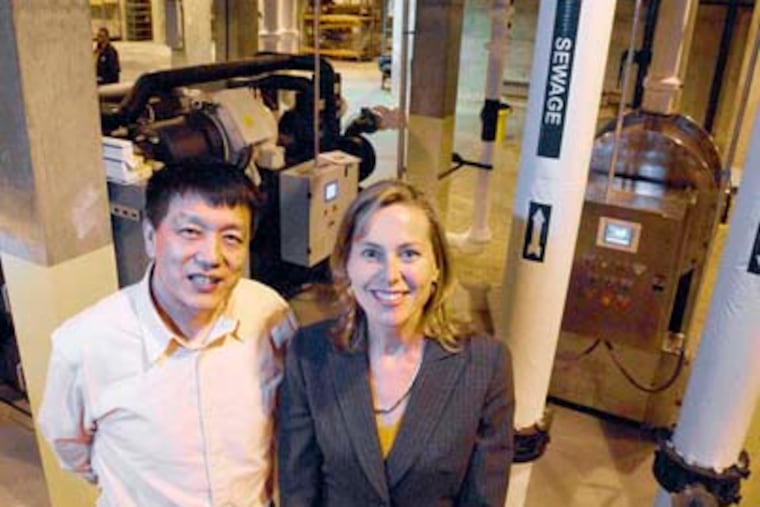Tapping into a constant resource: sewage's heat
Among the many renewable energy sources - wind, solar, hydroelectric, biofuels - there is one to which we all contribute that has not yet managed to attract the romantic advocates who have embraced other forms of green energy. We're speaking about the gray river of warmth flowing right beneath our feet: sewage.

Among the many renewable energy sources — wind, solar, hydroelectric, biofuels — there is one to which we all contribute that has not yet managed to attract the romantic advocates who have embraced other forms of green energy.
We're speaking about the gray river of warmth flowing right beneath our feet: sewage.
A Philadelphia company, NovaThermal Energy L.L.C., wants to heat and cool buildings by tapping into the constant, guaranteed heat contained in wastewater. The process is called sewage geothermal.
"It's just like geothermal energy, but we're using a different well source, so to speak," said Elinor Haider, NovaThermal's chief executive.
Public officials including Mayor Nutter will cut the ribbon Thursday on NovaThermal's first project, a pilot plant at Philadelphia's Southeast Wastewater Treatment Plant, near the Walt Whitman Bridge. NovaThermal is planning to install a second, commercial-sized project later this year at a sewage-treatment plant in Camden.
Haider said the initial projects are located at treatment plants only because they are public buildings with abundant sources of wastewater. But, she added, the company plans to market its patented Chinese technology to any large building located near a major sewer trunk line that contains a steady flow of wastewater still warm from its previous use.
In China, where the technology was pioneered, several large buildings have successfully employed the technology for heating and air-conditioning, including a hotel and a 1 million-square-foot train station in Beijing and a 450,000-square-foot high-rise apartment in Tianjin, China's third-largest city.
Wastewater picks up heat from a number of sources, including dishwashers, showers, and industrial processes, said Jimmy W. Wang, NovaThermal's chief engineer. There's also the "biomatter" that still contains heat, Wang said during a visit to the project Wednesday, although he used more scatological terminology.
During the winter, sewage is about 60 degrees, and in summer it can exceed 75 degrees. That's plenty of energy that can be extracted through a conventional heat pump.
Haider said the technology is more efficient and cost-effective than traditional geothermal systems, in which deep water wells are drilled into the bedrock to capture heat from the Earth.
The Philadelphia pilot project, which is funded by a $150,000 federal stimulus grant, is expected to reduce energy costs 40 percent, she said. It is expected to pay itself off in eight years, though full-scale projects would have a quicker return on investment.
But sewage geothermal has some image challenges. Haider said she must remind squeamish prospects that their buildings already contain sewer systems, so piping the stuff in for a quick passage through a heat pump is no big deal.
For Haider, a former city development official with a Wharton MBA and the mother of three, her current line of work is the source of some interesting conversations.
"There's a lot of potty talk at my family table," she said.
NovaThermal is not the only company marketing a sewage-geothermal process. A Swiss company, Rabtherm Energy Systems A.G., is promoting a patented idea that involves piping water through a network of embedded tubes inside concrete sewer mains. The water captures heat from passing wastewater.
Rabtherm's process involves replacing public sewer mains. NovaThermal's technology taps into existing sewer lines and diverts some flow into a heat exchanger.
"The competitiveness that we offer, on the cost side of the things, is that we're using infrastructure that's already in the ground," Haider said.
NovaTherm's process was developed by Jin Da Di Energy Engineering & Technology Co. Ltd. in Tianjin. "It's very unusual to see Chinese technology transfer this direction," she said. "Usually, it's reversed."
Wang, NovaTherm's chief engineer, managed public water projects, including construction of a 150-mile canal to deliver fresh water to Tianjin's 12 million residents, before he was recruited to help sell the sewage-geothermal process outside China.
The critical, proprietary part of the NovaThermal process is a device that filters the sewage before it flows through the heat pump, removing larger debris that might damage the pump. Chinese translators labeled the cylindrical device the "Anti-Block Machine."
The machine automatically squirts a quarter-inch screen with jets of water to prevent buildup of "dirt and filth material," according to the patent information filed with the World Intellectual Property Organization.
On Wednesday, Matt Moses, building supervisor of the Southeast Wastewater plant, surveyed the machinery, bathed in fluorescent lights in the basement of the plant's 20,000-square-foot compressor building, which now gets all its heat from the wastewater contained in vast tanks outside.
Moses said it's well known that sewage is warm.
"You can see the steam rising from it in the winter," he said. "I'm surprised nobody thought about this sooner."
Contact Andrew Maykuth at 215-854-2947 or amaykuth@phillynews.com or follow on Twitter @Maykuth